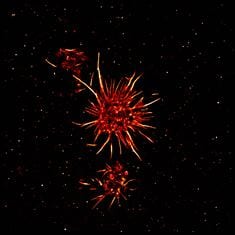
easySTORM (Source: Photonics Group, Imperial College London)
easySTORM: a robust, lower-cost approach to localization and TIRF microscopy
A broad range of new microscopy methodologies have recently been introduced collectively referred to as “super-resolved microscopy (SRM)”. They offer resolution measured in tens of nanometers or less – overcoming the diffraction limit and thereby opening up a wealth of new possibilities for biological studies. There is an increasing emphasis now on making SRM techniques and instrumentation more accessible. Their implementation with commercially available instrumentation typically requires complete new microscope systems to be purchased, which are relatively expensive. While techniques such as stimulated emission depletion (STED) microscopy and structured illumination microscopy (SIM) should be integrated into tailored microscopes, localization microscopy techniques can be implemented on existing wide-field or total internal reflection fluorescence (TIRF) microscopes.
Researchers from the Imperial College London now adapted an existing wide-field epifluorescence microscope for localization microscopy. They developed a straightforward and relatively low-cost approach to implement stochastic optical reconstruction microscopy (STORM) and TIRF – a usually significantly complex and costly affair.
For their new approach, which they called “easySTORM”, the scientists took advantage of multimode optical fibers and multimode diode lasers to provide the required excitation light. Combined with open source software and relatively simple protocols to prepare samples for STORM, including the use of Vectashield for non-TIRF imaging, this enables TIRF and STORM imaging of cells labeled with appropriate dyes or expressing suitable fluorescent proteins.
The costs of the components needed for the new setup amounted to less than about ₤ 20,000. The scientists believe this should enable manufacturers to reduce costs and research groups to upgrade existing instruments such that these techniques can be routinely implemented for biological studies.
(Source: K. Maedefessel-Herrmann).

















